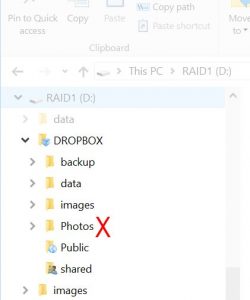
Services like Dropbox, Microsoft OneDrive, Google Drive and others make it very easy to backup files into the cloud. This is often used as a second or third tier backup strategy. In addition to local backups of all your important files for easy and quick recovery.
This know-how article explains how your can integrate cloud storage with IMatch.
Keep It Local
All of the above cloud providers allow you to use a mode where you keep a local copy of all the files managed in the cloud. This makes these files accessible for all applications on your computer — without any special software and also very fast. If you change a file in one of the cloud backed folders, it is automatically synchronized with the cloud storage. If you change files on another computer which is synchronized with your cloud, the changed files are automatically downloaded to all your other computers.
Integrate with IMatch
This is exactly the way to do it when you want to manage your files in IMatch and use the cloud to store your files.

You just include the folders in the local copy of your cloud storage (e.g., the Photos sub-folder in the Dropbox folder) in your IMatch database.
This way you can manage the files in IMatch, search, view, edit metadata etc.
Whenever you change a file in IMatch, the file is synchronized back into the cloud automatically. And when you change files on other systems and the cloud synchronizes your local copy with the cloud afterwards, IMatch detects the new and updated files and updates the database.
This gives you the best of both worlds. IMatch and integrated cloud storage.
IMatch Databases in Cloud Storage
As a backup, great. Just copy your IMatch database(s) into your cloud folders at regular intervals or let Windows do it with a scheduled task. Keeping a live database in cloud storage, however, can be problematic and sometimes even dangerous.
When IMatch has a database open, it creates temporary files, lock files and short-lived transaction journal files. These files come and go as needed by the database system. They enable IMatch to cleanly undo failed database operations, to recover from catastrophic events like power failures and to handle multi-user scenarios. And of course IMatch updates database file several times per second.
When IMatch closes a database, all temporary files are removed and only the .imd* database file remains. The database is then in a clean state and ready for backup.
Not Recommended for ‘Live’ Databases…
But when you keep your ‘working’ IMatch databases in the local Dropbox folder, this is what happens:
Dropbox recognizes that the database file has changed and that temporary files have been added, updated or removed. It then starts to synchronize these files into the cloud. While Dropbox is doing this, IMatch continues to update the database, creating and removing temporary files. Whatever ends up in the cloud is most likely outdated and inconsistent. Nothing you can rely on as a backup.
And there might be a performance penalty, too. If Dropbox is locking files while it processes them, IMatch may be slowed down or even run into timeouts.
For these reasons, it is not recommended to keep ‘live’ IMatch databases in Dropbox. You can copy a closed database into a Dropbox folder for backup purposes. But not while IMatch (or IMatch WebServices™) have the database open.
I used Dropbox as an example here, but the same behavior can also be found with Microsoft OneDrive or Google Drive.
Find other interesting articles in the DAM Knowledge Base.

